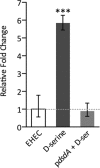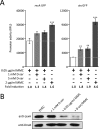Intracellular d-Serine Accumulation Promotes Genetic Diversity via Modulated Induction of RecA in Enterohemorrhagic Escherichia coli
- PMID: 27698085
- PMCID: PMC5116935
- DOI: 10.1128/JB.00548-16
Intracellular d-Serine Accumulation Promotes Genetic Diversity via Modulated Induction of RecA in Enterohemorrhagic Escherichia coli
Abstract
We recently discovered that exposure of enterohemorrhagic Escherichia coli (EHEC) to d-serine resulted in accumulation of this unusual amino acid, induction of the SOS regulon, and downregulation of the type III secretion system that is essential for efficient colonization of the host. Here, we have investigated the physiological relevance of this elevated SOS response, which is of particular interest given the presence of Stx toxin-carrying lysogenic prophages on the EHEC chromosome that are activated during the SOS response. We found that RecA elevation in response to d-serine, while being significant, was heterogeneous and not capable of activating stx expression or stx phage transduction to a nonlysogenic recipient. This "SOS-like response" was, however, capable of increasing the mutation frequency associated with low-level RecA activity, thus promoting genetic diversity. Furthermore, this response was entirely dependent on RecA and enhanced in the presence of a DNA-damaging agent, indicating a functional SOS response, but did not result in observable cleavage of the LexA repressor alone, indicating a controlled mechanism of induction. This work demonstrates that environmental factors not usually associated with DNA damage are capable of promoting an SOS-like response. We propose that this modulated induction of RecA allows EHEC to adapt to environmental insults such as d-serine while avoiding unwanted phage-induced lysis.
Importance: The SOS response is a global stress network that is triggered by the presence of DNA damage due to breakage or stalled replication forks. Activation of the SOS response can trigger the replication of lytic bacteriophages and promote genetic diversification through error-prone polymerases. We have demonstrated that the host-associated metabolite d-serine contributes to Escherichia coli niche specification and accumulates inside cells that cannot catabolize it. This results in a modulated activation of the SOS antirepressor RecA that is insufficient to trigger lytic bacteriophage but capable of increasing the SOS-associated mutation frequency. These findings describe how relevant signals not normally associated with DNA damage can hijack the SOS response, promoting diversity as E. coli strains adapt while avoiding unwanted phage lysis.
Copyright © 2016, American Society for Microbiology. All Rights Reserved.
Figures





Similar articles
-
Regulation of the SOS response in Bacillus subtilis: evidence for a LexA repressor homolog.J Bacteriol. 1991 Oct;173(20):6489-98. doi: 10.1128/jb.173.20.6489-6498.1991. J Bacteriol. 1991. PMID: 1917874 Free PMC article.
-
Genetic evidence for the requirement of RecA loading activity in SOS induction after UV irradiation in Escherichia coli.J Bacteriol. 2006 Jul;188(14):5024-32. doi: 10.1128/JB.00130-06. J Bacteriol. 2006. PMID: 16816175 Free PMC article.
-
Overexpression of the LexA-regulated tisAB RNA in E. coli inhibits SOS functions; implications for regulation of the SOS response.Nucleic Acids Res. 2008 Nov;36(19):6249-59. doi: 10.1093/nar/gkn633. Epub 2008 Oct 1. Nucleic Acids Res. 2008. PMID: 18832374 Free PMC article.
-
Mutations for Worse or Better: Low-Fidelity DNA Synthesis by SOS DNA Polymerase V Is a Tightly Regulated Double-Edged Sword.Biochemistry. 2016 Apr 26;55(16):2309-18. doi: 10.1021/acs.biochem.6b00117. Epub 2016 Apr 12. Biochemistry. 2016. PMID: 27043933 Free PMC article. Review.
-
Inducible SOS response system of DNA repair and mutagenesis in Escherichia coli.Int J Biol Sci. 2008 Sep 23;4(6):338-44. doi: 10.7150/ijbs.4.338. Int J Biol Sci. 2008. PMID: 18825275 Free PMC article. Review.
Cited by
-
A master regulator of central carbon metabolism directly activates virulence gene expression in attaching and effacing pathogens.PLoS Pathog. 2024 Oct 15;20(10):e1012451. doi: 10.1371/journal.ppat.1012451. eCollection 2024 Oct. PLoS Pathog. 2024. PMID: 39405360 Free PMC article.
-
Control of resistance against bacteriophage killing by a metabolic regulator in meningitis-associated Escherichia coli.Proc Natl Acad Sci U S A. 2022 Nov 8;119(45):e2210299119. doi: 10.1073/pnas.2210299119. Epub 2022 Nov 2. Proc Natl Acad Sci U S A. 2022. PMID: 36322762 Free PMC article.
-
Effect of diet on pathogen performance in the microbiome.Microbiome Res Rep. 2022 Mar 26;1(2):13. doi: 10.20517/mrr.2021.10. eCollection 2022. Microbiome Res Rep. 2022. PMID: 38045644 Free PMC article. Review.
-
Genomic plasticity of pathogenic Escherichia coli mediates d-serine tolerance via multiple adaptive mechanisms.Proc Natl Acad Sci U S A. 2020 Sep 8;117(36):22484-22493. doi: 10.1073/pnas.2004977117. Epub 2020 Aug 26. Proc Natl Acad Sci U S A. 2020. PMID: 32848072 Free PMC article.
-
The role of l-arabinose metabolism for Escherichia coli O157:H7 in edible plants.Microbiology (Reading). 2021 Jul;167(7):001070. doi: 10.1099/mic.0.001070. Microbiology (Reading). 2021. PMID: 34319868 Free PMC article.
References
-
- Fernández De Henestrosa AR, Ogi T, Aoyagi S, Chafin D, Hayes JJ, Ohmori H, Woodgate R. 2000. Identification of additional genes belonging to the LexA regulon in Escherichia coli. Mol Microbiol 35:1560–1572. - PubMed
MeSH terms
Substances
LinkOut - more resources
Full Text Sources
Other Literature Sources

